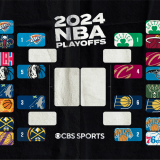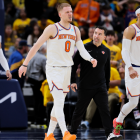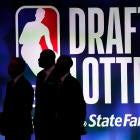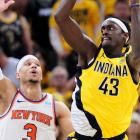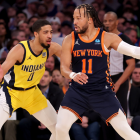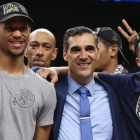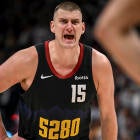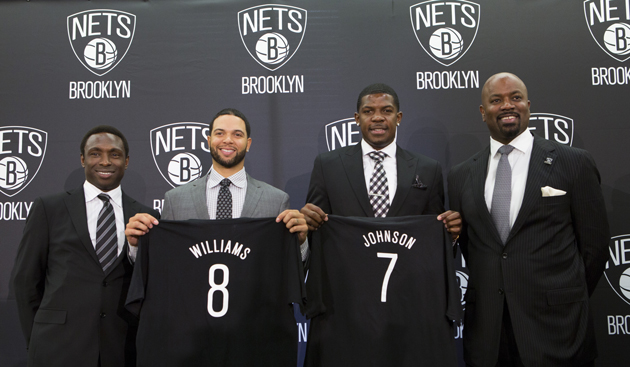 |
| Brooklyn Nets. (Getty Images) |
Over the next month, CBSSports.com's Eye On Basketball will take a team-by-team look at the 2012 NBA offseason. Next up: the Brooklyn Nets. You can find our offseason reports here.
I. How they finished 2012: A better question: Where did the Nets finish 2012? That would have been New Jersey, and not Brooklyn, where the franchise will kick off a new, promising era in 2012-13.
The Nets' final season in the Garden State ended in familiar fashion: in front of sparse crowds and in the Atlantic Division basement. New Jersey finished 2011-12 with the lowest average home attendance in the NBA and a record of 22-44, marking the fifth straight season the team had failed to advance to the postseason.
What's more, the team appeared headed for a potentially catastrophic crossroads: franchise point guard Deron Williams was entering free agency as the 2012 class's clear No. 1 player. Midseason trade acquisition Gerald Wallace (who cost the Nets their 2012 lottery pick) and productive forward Kris Humphries were both unrestricted free agents too, and promising center Brook Lopez was headed for a likely max offer as a restricted free agent.
The Nets, on paper, looked to be in a serious bind: they were a below-average team without a 2012 lottery pick that needed to fork over big, big dollars just to keep its sub-mediocre core together or risk a future that looked even more grim. This was bad reaching the precipice of disaster.
II. Needs entering the offseason: The biggest need, by far, was to re-sign Deron Williams, ranked the No. 16 player in the league during the latest edition of the CBSSports.com Elite 100. The Nets held a trump card with their ability to sign Williams to a 5-year contract while suitors could only offer four years, but the team's history of losing and weak supporting cast didn't make a Williams re-commitment a slam dunk by any stretch, especially with his hometown Dallas Mavericks looming as a major competitor for his services.
Deciding Lopez's future was another item high on the priority list. A skilled and mobile 7-footer who missed virtually all of the 2011-12 season due to injury, Lopez wa a logical trade chip in the pursuit of Dwight Howard and a solid back-up plan in case those trade talks fizzled out. While not quite a star, Lopez's career averages of 17.4 points and 7.5 rebounds represent above-average production and his age, 24, suggests untapped potential.
After spending the lottery pick required to obtain Wallace in trade from the Portland Trail Blazers, the Nets put themselves in a position where they couldn't let him walk for nothing. A two-way wing known for his energetic play, Wallace, who turned 30 in July, was seeking one last, long-term pay day.
Maintaining the status quo might not have been enough to keep Williams around. The Nets, then, needed to upgrade the talent level on their roster in a meaningful way, or face the reality of a discontented superstar in his prime at 28 years old who might have been willing to sacrifice big dollars for a better shot at winning now.
III. The Draft: Significant roster improvement would not come through the Draft. That simply wasn't the team's strategy, made clear by their decision to only add top-3 protections to the 2012 first-round pick they sent to the Blazers for Wallace. They realized, once the trade was completed, that it would take lottery luck for them to keep their pick. Luck didn't strike and the pick was conveyed.
With no Draft splash forthcoming, the Nets swung two minor second-round trades, acquiring Tyshawn Taylor and Tornike Shengelia. They also selected Ilkan Karaman. As with all second-round picks, expectations are not huge.
IV. Free Agency: If the Nets punted on the Draft, they went for it on fourth down over and over and over when it came to their free agency and trade strategy. The scope of the progress on these fronts is a little mind-boggling. In all, Brooklyn succeeded in retaining all of its key roster pieces and significantly upgrading its roster. Entering the offseason, this would have been considered the best case scenario (besides acquiring Dwight Howard, of course).
The only catch: the Nets will be paying through their noses to do it. Williams signed a 5-year maximum deal worth $98 million (on an iPad!). Lopez signed a 4-year mini-max deal worth $61 million. Wallace was overpaid to the tune of $40 million over 4 years and Humphries got a raise, signing a 2-year deal worth $24 million.
In addition to all that retention spending, the Nets orchestrate a major trade with the Atlanta Hawks for All-Star guard Joe Johnson, agreeing to take on the four years and $89 million remaining on his contract. Bam. Goodbye future flexibility.
The rest of the free agency moves were of the "filling out the rotation" variety. Bosnian forward Mirza Teletovic comes in a mini mid-level deal. Reserve guard C.J. Watson arrives from the Chicago Bulls, reserve forward Reggie Evans arrives from the Los Angeles Clippers, and reserve wing Jerry Stackhouse arrives from a retirement facility.
V. Overall grade and accomplishments: A-
It would be easy to dismiss Brooklyn's moves as simply throwing as much money as possible at a problem while achieving solid -- but not spectacular -- improvement. It would be easy to do that because that's exactly what happened.
While this approach isn't always recommended, this specific time and place made it particularly logical. The Nets needed to keep Williams, they needed to keep him happy, they needed to put a big time product on the floor in Brooklyn and they needed to do so without a real 2012 Draft asset. Indeed, many of those conditions were of their own making. But plenty of teams find themselves in roster pinches and are unable or unwilling to put together a plan -- especially one that involves heavy spending -- that will lead to short-term improvement.
Once the dust settled, the Nets have a four-man core of All-Star or near All-Star talent in Williams, Johnson, Wallace and Lopez. All four are currently in or approaching their prime and complement each other well enough. The quartet, while expensive (outrageously so in some cases), didn't come at the expense of a bench, as Brooklyn's rotation can comfortably go eight players deep.
The Nets remain two pegs below the Miami Heat, your presumptive 2013 Eastern Conference champions. They also trail the Chicago Bulls (with a healthy Derrick Rose) and the Boston Celtics (still old, still good) in the standings. After that, though, they are in the conversation for a potential homecourt seed in the first-round of the playoffs. That also puts them in the "Maybe they could make a run to the Finals if one of Miami's Big 3 gets injured" conversation.
Needing to rely on a major injury to a clearly superior opponent to generate deep postseason success isn't the best place to be. But the Heat are not a fair standard for the Nets, at least not this summer. To grade this series of moves, one must look back at the 2011-12 Nets (the Nets are now way better than that group) and what the 2012-13 Nets could have looked like if this summer had played out in its worst case scenario (Williams leaves, Wallace leaves, Lopez re-signs for mini-max and no other marquee free agents are added, leaving the Nets as a Charlotte Bobcats level terrible team for the next 3-5 years).
Considering those circumstances -- how bad the Nets were last season and how truly pathetic they could have been had this summer played out differently -- Brooklyn emerges from the summer of 2012 as a big winner.
This was a "you must walk before you can run" summer for a franchise that had been crawling pitifully on its knees. Now, the Nets stride confidently into a new battle for Big Apple basketball supremacy.







